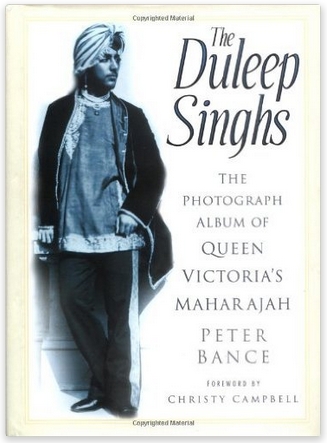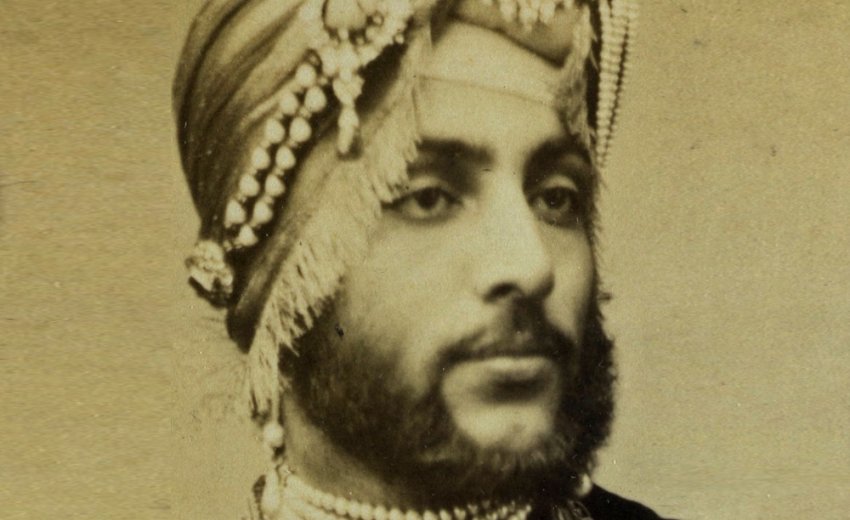 |
The Duleep Singhs: Product Dimensions: 20 x 2 x 27 cm A superb collection of photographs which tell the story of the Duleep Singhs, the family of the late Maharajah of the Punjab, who was exiled to Britain and became a favourite of Queen Victoria. About the Author Peter Bance is an independent researcher, specialising in Sikh history. He also operates a family real estate business. He has been researching Maharajah Duleep Singh since 1995, wrote the entry for Maharani Jindan for the New Dictionary of National Biography and also contributed to the research for the book The Maharajah's Box. He lives in Essex. |
A Review by Hardev Singh Virk
After my sentimental journey to Elveden in UK, where the last Maharaja of Sikh kingdom of Lahore lies burried in the church cemetery, my curiosity to collect information about the family of Maharaja Duleep Singh was aroused. The curator of Ancient House Museum at Thetford came to my help. I collected all information about new publications about Maharaja Duleep Singh and his family. The book under review is the latest in the series published in 2004.
As the title suggests, the book under review is a pictorial album of Maharaja Duleep Singh's family, being a lavishly illustrated account with almost 200 images of the Maharaja, the Maharani and their children. The book "The Duleep Singhs" is divided into eleven chapters. The historical origin of the Sikh kingdom is traced in the introduction. First chapter deals with the birth of Duleep Singh, his coronation as Maharaja and his surrender before the Governor General, Sir Henry Hardinge, in Lahore after defeat of the Khalsa Army in the first Sikh war. The pictures are based on paintings and engravings and illustrate the poignancy of the situation. One is moved to watch the surrender ceremony of eight year old Maharaja Duleep Singh and annexation of Sikh kingdom after the second Sikh war. Photography and Duleep Singh were contemporary phenomenon in India. A calotype photograph of the Maharaja in 1848 by John Mclosh is also included; which may be considered as the first photograph taken by using a camera in Punjab.
Chapter 2 deals with Maharaja's life in England. Under the tutelage of Dr John Login and Lena Login, Duleep Singh was deported to England in April 1854 and separated from his mother Rani Jind Kaur. Her Majesty Queen Victoria of England received Duleep Singh at Buckingham Palace on 1st July 1854. He became a favourite of the Queen and was accorded the rank of a European prince. The most beautiful paintings of Maharaja Duleep Singh were got prepared by the Queen in her presence from the topmost painters of Europe. Chapter 2 is fully illustrated by these paintings and photographs of palaces where Duleep Singh resided in England.
Chapter 3 describes Maharaja's trip to India, his emotional reunion with his mother Rani Jind Kaur, his second trip to India for the last rites of his mother, his marriage with Bamba Muller on his return journey at Cairo and return of the royal couple to England. The Maharaja was not allowed to visit Punjab to perform the last rites of his mother. She was cremated at Bombay and her ashes were immersed in the river Godavari at Nasik. The chapter includes two unique photographs of Maharaja Duleep Singh and Maharani Bamba in wedding robes. It was a Christian marriage ceremonised in the Presbyterian Church of Cairo.
Chapter 4 "The Suffolk Squire" is the most illustrated chapter of the book. In 1863, Maharaja Duleep Singh left London and purchased an estate of 17,000 acres in Elveden on the Norfolk-Suffolk border. He renovated Elveden Hall in the oriental style and raised his family of 6 children. Maharaja Duleep Singh indulged in his passion for hunting and shooting and arranged shikar parties for the royal guests, Prince of Wales. He was a great lover of shikar like his father. Imitating his royal friends, the Maharaja had a flirtatious nature. His notorious escapades to Paris and London clubs are mentioned in this chapter. He displayed all the virtues and vices of an oriental monarch and indulged in high life of London. The chapter illustrates the royal visitors to Elveden Hall residence of Maharaja, elite society ladies and Thakur Singh Sandhanwalia who was designated as Prime Minister-in-exile for Maharaja Duleep Singh later on. It was Thakur Singh who persuaded Maharaja to return to the Sikh faith and fight for his lost Sikh kingdom. The Maharaja was fully convinced of the betrayal and treachery played by the British and he revolted against the Empire.
Chapter 5 describes Maharaja's wish to return to India for taking khande di pahul. He was off-loaded the ship at Aden and ordered to return to England. Before his return, he was re-initiated into the Sikh faith as a Khalsa. His desire to visit Punjab was never fulfilled and in frustration he resigned his pension and took residence in Paris. He was so much annoyed with the British Empire in India that he joined a revolutionary group in France and travelled to Russia to seek help from the Russian Czar. The Maharaja was not a gifted conspirator. His Russian collaborator died and by a strange coincidence of misfortunes, he failed in his mission to liberate India from the clutches of British Empire. He died in a Paris hotel in utter frustration. This chapter narrates a sad story full of poignant details of Maharaja's life in Paris.
Chapters 6-10 are dedicated to the six children of Maharaja Duleep Singh: Princes Victor, Albert Edward and Frederick Duleep Singh and Princesses Catherine, Sophia and Bamba Duleep Singh. Maharaja wanted his eldest son to marry in India but he did not agree calling the Maharaja 'my idiotic father'. Victor studied at Eton and Cambridge where he met his true love, Anne Blanche of Coventry and married her. Duleep Singh did not attend the marriage ceremony. Even Queen Victoria was not happy with Victor over this marriage. She treated Victor as her god-son. She called the Princess Anne, the pretty wife of Victor to her audience and ordered her to leave England and take a vow never to have children, they would be heir apparent of the Sikh Kingdom. The couple followed the royal command faithfully and never returned to England.
Albert Edward Duleep Singh died at the young age of thirteen. Maharaja Duleep Singh visited from Paris to see his ailing son and wept bitterly but he returned and could not attend his funeral. Prince Frederick Duleep Singh was the most talented of all the Princes. He went to Cambridge and got an MA degree in history. He was a keen collector of old books, coins, stained glass and other artifacts. He was a kind-hearted man and became very popular in his County as the 'Black Prince'. He was historian, archaeologist, philanthropist and a great lover of music. He was keen to promote the legacy of Maharaja Duleep Singh. Keeping this in view, he donated all his art collection to set up the Ancient House Museum in Thetford, which is a living testimony to the family of Maharaja Duleep Singh. Chapter 7 is fully illustrated depicting the life of Frederick Duleep Singh, who remained a bachelor all his life.
The author has devoted three chapters to Princesses Catherine, Sophia and Bamba Duleep Singh. Catherine was ranked as one of the most beautiful European princesses but she did not marry. She spent most of her time in Germany with her governess, Lina Schafer. Princess Sophia was the youngest of the three sisters, a firebrand like her father and became a leading figure fighting for the voting rights of women in England. During the First World War, Princess Sophia visited wounded Punjabi troops in the Indian army and gave them mementos as a grand daughter of Maharaja Ranjit Singh. She kept her links with the family of Takhur Singh Sandhanwalia who served his father faithfully and offered to adopt Pritam Singh as her son.
Princess Bamba Duleep Singh was the most colourful character in Duleep Singh's family. She was a rebel like her father and began styling herself as the 'Queen of the Punjab'. She frequently visited India and married Colonel Sutherland who became Principal at King Edward's Medical College, Lahore. Once Sophia and Bamba visited Lahore in 1924 and the crowds gathered from Punjab villages to see the daughters of their last king, Duleep Singh. The police dispersed the crowd, as it was thought to be politically too dangerous for the British Empire. Princess Bamba visited Khalsa College, Amritsar during the 1940s and in 1944 she shifted to Lahore. She never accepted the partition of Punjab and settled in Lahore, the capital of Sikh kingdom, as a permanent resident. She set up a museum in Lahore fort, which is known as 'Princess Bamba Collection'. The last member of Duleep Singh family, Princess Bamba died on 10 March 1957 and is buried in the Christian Cemetery in Lahore.
'The legacy of Maharaja Duleep Singh' is the last chapter of the book by Peter Bance. It is followed by Maharaja Duleep Singh's family tree. One wonders, how all the direct descendants of Maharaja Ranjit Singh vanished leaving no heir apparent. All of them died issueless as a consequence of Guru's prophecy; it is a myth created in Punjab.
After procuring the book from Sutton Publishing, UK, another riddle appeared before me about the identity of its author, Peter Bance. On the internet, I requested for his biodata. It was a pleasant surprise that Peter Bance is a third generation Sikh (nee Bhupinder Singh), settled in England. He is a keen collector of Sikh antiques, including an unrivalled collection on the Duleep Singhs' which form part of the book under review. I congratulate the young author (29 years) of Duleep Singhs' for writing this illustrated historical album after a strenuous research of eight years. The book will prove to be a collector's choice and should decorate the drawing room of every Sikh family keen to probe its heritage.






